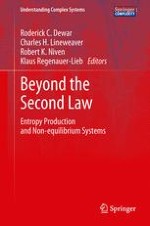2014 | OriginalPaper | Buchkapitel
9. Predictive Use of the Maximum Entropy Production Principle for Past and Present Climates
verfasst von : Corentin Herbert, Didier Paillard
Erschienen in: Beyond the Second Law
Verlag: Springer Berlin Heidelberg
Aktivieren Sie unsere intelligente Suche, um passende Fachinhalte oder Patente zu finden.
Wählen Sie Textabschnitte aus um mit Künstlicher Intelligenz passenden Patente zu finden. powered by
Markieren Sie Textabschnitte, um KI-gestützt weitere passende Inhalte zu finden. powered by
